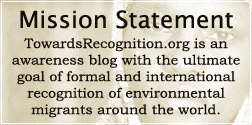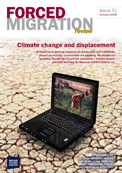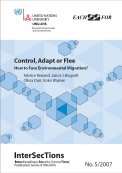edToolbar()
Refugees forced to leave their homes because of floods, droughts, storms, heatwaves and other effects of climate change are likely to be one of the biggest visible effects of the warming that scientists warn will r
esult from the untrammelled use of fossil fuels, according to the UK government’s Foresight group, part of the Office for Science, in a report entitled Migration and Global Environmental Change .
But many of those people are likely to move from areas affected by global warming into areas even worse afflicted – for instance, by moving into coastal cities in the developing world that are at risk of flood from storms and rising sea levels.
“Millions will migrate into, rather than away from, areas of environmental vulnerability,” said Sir John Beddington, chief scientific advisor to the UK government, and head of the Foresight programme. “An even bigger policy challenge will be the millions who are trapped in dangerous conditions and unable to move to safety.”
Scientists found that between 114 million and 192 million more people were likely to be living in floodplains in urban areas of Africa and Asia by 2060, partly as a result of climate change.
People who are trapped by warming – either because they cannot move from their homes, or because they have moved but are unable to find better places to live – will represent “just as important a policy concern as those who do migrate”, the report concluded. “Environmental change is equally likely to make migration less possible, as more probable.”
Last year, according to the United Nations, 210 million people – about 3% of the global population – migrated between countries, and in 2009 about 740 million people moved within countries.
But the scientists also said that migration should not be seen simply as a problem – in many cases, it is a sensible solution to the environmental changes caused by a warming climate, and can be managed if governments make adequate preparations. “Migration can be a good option – it is a way of adapting to climate change,” said Neil Adger, professor of environmental economics at the University of East Anglia. “We should be planning for migration pro-actively, to ensure that the necessary infrastructure is in place for people.”
He said that equipping cities in developing
countries with adequate infrastructure, including access to clean water, sanitation and energy, was a key concern. Funds devoted to helping countries cope with the effects of climate change should also be spent with this in mind, he said.
Although the scientists who wrote the report declined to put an estimate on the number of people likely to be displaced, they said it was “undeniable” that migration would be a major factor, and one that would be potentially destabilising to established governments.
Previous attempts to put an estimate on the number displaced have met with controversy – a prediction by the United Nations Environment
Programme that 50 million people would be forced to migrate by climate change by 2010 was attacked by climate change sceptics, who said there was no proof of how many of the 210 million people who moved across borders in that year had been forced to flee by environmental conditions.
The Foresight programme scientists said there were many factors influencing migration, but that climate change was likely to become a much more significant factor in the next 20 to 30 years.
Trying to stop migration from global warming may be the wrong approach, the scientists warned. Andre Geddes, professor of politics at the University of Sheffield, said: “Policies that just seek to prevent migration are risky.”
Instead, governments should attempt to anticipate movement and find ways to improve conditions, both in the places people are likely to move to, and those they are likely to move from.
edCanvas = document.getElementById(‘content’);




The UN Emergency Relief Coordinator and other aid agency heads underlined the need to help communities become more resilient, so they could face extreme climate events rather than being forced to flee their homes permanently. Holmes said other mechanisms to raise money to help poor countries would have to be found. “Let’s face it,” he told IRIN, the amount needed will not be put on the table by the rich countries in Copenhagen.
However, Walter Kälin, Representative of the UN Secretary-General on the Human Rights of Internally Displaced Persons, said the message to donors was that they should rather fund initiatives to help poor countries adapt now, as “it will be much cheaper.”
Holmes, Kälin and António Guterres, the UN High Commissioner for Refugees, who also addressed a press briefing in Copenhagen, have been in the front line of providing assistance to people displaced by climate-related natural disasters, which are projected to become more frequent and intense in future. So-called environmentally induced migration is multi-level problem. According to Essam El-Hinnawi definition form 1985 environmental refugees as ―those people who have been forced to leave their traditional habitat, temporarily or permanently, because of a marked environmental disruption (natural or triggered by people) that jeopardised their existence and/or seriously affected the quality of their life. The fundamental distinction between `environmental migrants` and `environmental refugees` is a standpoint of contemporsry studies in EDPs.
According to Bogumil Terminski it seems reasonable to distinguish the general category of environmental migrants from the more specific (subordinate to it) category of environmental refugees.